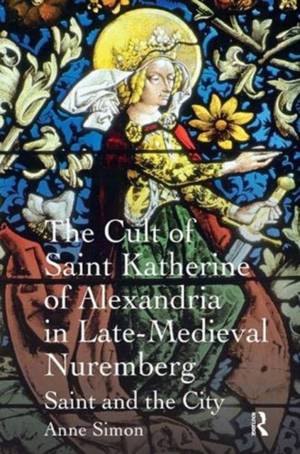
Door een staking bij bpost kan je online bestelling op dit moment iets langer onderweg zijn dan voorzien. Dringend iets nodig? Onze winkels ontvangen jou met open armen!
- Afhalen na 1 uur in een winkel met voorraad
- Gratis thuislevering in België vanaf € 30
- Ruim aanbod met 7 miljoen producten
Door een staking bij bpost kan je online bestelling op dit moment iets langer onderweg zijn dan voorzien. Dringend iets nodig? Onze winkels ontvangen jou met open armen!
- Afhalen na 1 uur in een winkel met voorraad
- Gratis thuislevering in België vanaf € 30
- Ruim aanbod met 7 miljoen producten
Zoeken
The Cult of Saint Katherine of Alexandria in Late-Medieval Nuremberg
Saint and the City
Anne Simon
Paperback | Engels
€ 64,95
+ 129 punten
Uitvoering
Omschrijving
Katherine of Alexandria was a major object of devotion within medieval Europe, ranking second only to the Virgin Mary in the canon of female saints. Yet despite her undoubted importance, relatively little is known about the significance and function of her cult within the German-speaking territories that stood at the heart of Europe. Anne Simon's study adds a welcome new interdisciplinary perspective to the study of Saint Katherine and the wider ecclesiastical landscape of a medieval Europe poised on the edge of religious change. Taking as a case study the wealthy and politically influential merchant city of Nuremberg, this book draws on a wide variety of textual and visual sources to explore interrelated themes: the shaping of urban space through the cult of Saint Katherine; her role in the moulding and advertising patrician identity and alliances through cultural patronage; and patrician use of the saint to showcase the city's political, economic, cultural and religious importance at the heart of the Holy Roman Empire. Further, the book reveals the construction of exemplarity in Saint Katherine's legend and miracles and their resonance within the context of the city and the Dominican Convent of Saint Katherine, whose nuns came from the same status-aware, confident patrician elite that so loyally supported successive Emperors. Filling a significant gap in current research, the work has much to offer scholars of medieval history, hagiography, art history, German studies, cultural and urban studies. Hence it not only expands our understanding of Saint Katherine's importance in German-speaking territories, but also adds to the picture of her cult in its European perspective.
Specificaties
Betrokkenen
- Auteur(s):
- Uitgeverij:
Inhoud
- Aantal bladzijden:
- 336
- Taal:
- Engels
Eigenschappen
- Productcode (EAN):
- 9781138379725
- Verschijningsdatum:
- 10/06/2019
- Uitvoering:
- Paperback
- Formaat:
- Trade paperback (VS)
- Afmetingen:
- 156 mm x 234 mm
- Gewicht:
- 471 g

Alleen bij Standaard Boekhandel
+ 129 punten op je klantenkaart van Standaard Boekhandel
Beoordelingen
We publiceren alleen reviews die voldoen aan de voorwaarden voor reviews. Bekijk onze voorwaarden voor reviews.











